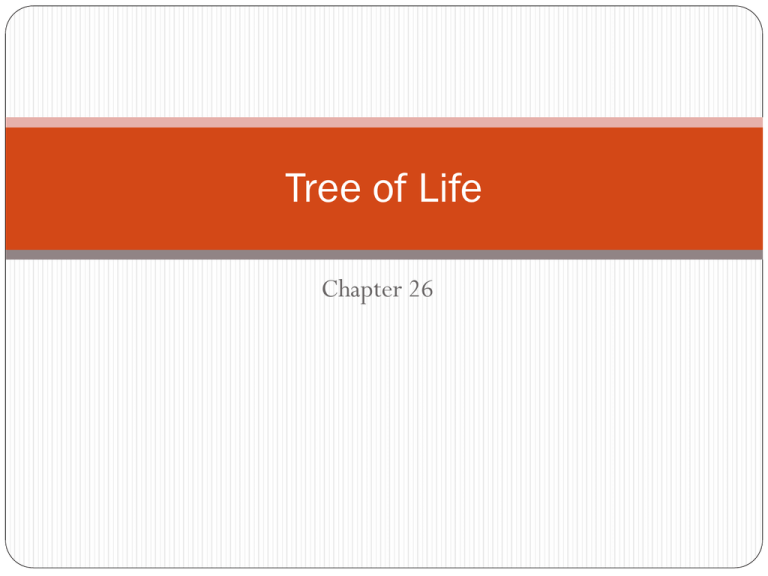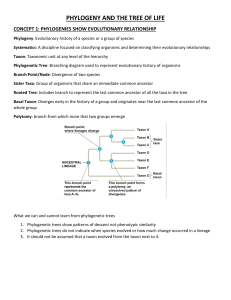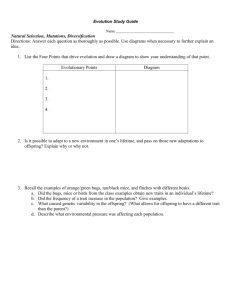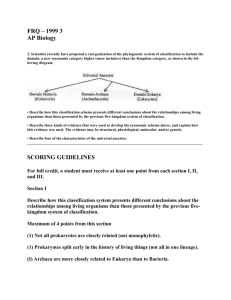Introduction to Biological Diversity
advertisement

Tree of Life Chapter 26 Where Are We Going? Taxonomy Scientific discipline of classifying and naming organisms Phylogeny Interpreting diagrams of evolutionary history Application What evolutionary history says about biological diversity Binomial Nomenclature Common names for casual usage, but not accurate What animals come to mind you when hear the word ‘fish’? Different words depending on language Biologist use Latin scientific names Carolus Linnaeus 2 part system: genus and specific epithet Homo sapiens or Panthera pardus Hierarchical (Linnaean) Classification Linnaeus grouped named animals into categories genus Panthera: leopard (P. pardus), lion (P. leo), tiger (P.tigris), & jaguar (P. onca) Based on morphological similarities Used by taxonomists Taxon is any level of the hierarchy Review: How can you remember the hierarchical order of taxons? Doesn’t always reflect evolutionary history Phylogenetic Trees Diagrams hypotheses of evolutionary history of organisms Degree of relatedness to ancestors Used by systematists Can reclassify if mistake found Only implies pattern of descent, not time or age Branch means common ancestor, not taxon from taxon Reading Phylogenetic Trees Series of branch points Root is last common ancestor of tree Sister taxa share an immediate ancestor Which of the trees below depicts a different evolutionary history from the other two? Homology vs Analogy Homologies are similarities due to shared ancestry Used to construct phylogenies Analogies are similarity due to convergent evolution What is convergent evolution? ‘Moles’: marsupial vs eutherian; similar lives Wings: bats vs. insects vs. birds; relation to cats More points of resemblance make more likely ancestor was shared Applies to morphological and molecular similarities Constructing Phylogenetic Trees Must first separate homologous from analogous Systematists then infer phylogeny using cladistics Using common ancestry to classify organisms Create clades or groups containing an ancestral species and all descendants Clades vs. Taxons Similar to taxons because both are nested groups Equivalent only if it is monophyletic, containing ancestor and ALL descendants Paraphyletic contains ancestor and SOME descendants Polyphyletic contain taxa with different ancestors Shared … Characteristics Ancestral originates in an ancestor of the taxon Backbones are an example for mammals, why? Derived is a novelty unique to a clade Hair is an example for mammals, why? Ancestral can qualify as derived at deeper branches What branch point allows backbones to be shared derived characteristics? Constructing Phylogenies Use the 1st appearance of each shared derived characteristic Determine the outgroup and ingroup Determined from morphology, paleontology, embryonic development, or genes Compare members of the ingroup to each other and to the outgroup The Genome’s Role in Phylogeny Nucleic acids and other molecules are also used to determine and test hypotheses about evolutionary relationships Important for organisms that are unlikely to have morphological similarities or organisms without fossil records Fungi, plants, and animals Prokaryotes and other microorganisms Determine relationships at all levels of the Tree of Life Rates of gene evolution varies rRNA is slow = good for relationships that diverged 100’s of millions of years ago mtDNA is rapid = good for recent evolution Evolving Genomes Orthologous genes Homologous genes in different species through speciation Can diverge only after speciation E.g cytochrome C (ETC protein) Paralogous genes From gene duplication = multiple copies in the same genome Can diverge within a species E.g 1000’s of olfactory receptors Humans and mice 99% orthologous; and yeast 50% The Changing Tree of Life Initially 2 Kingdoms Plants: bacteria (cell wall), chloroplast organims, fungi (sessile) Animals: protozoans (movement and eat) 5 Kingdoms Monera: prokaryotes Protista: unicellular organisms Plantae, Fungi, and Animalia: eukaryotes Recently 3 Domains Molecular evidence that prokaryotes as different from each other as eukaryotes Bacteria: most prokaryotes, close to chloroplasts and mitochondria Archaea: diverse prokaryotes living in extreme environments Eukarya: cells with true nuclei Domain Systems 1 example of Life’s connections Most of living organisms are single-celled Red lines are multicellular Monera gone because it contains 2 domains Protista disappearing due to diversity and similarity to other eukarya Alternate Form of Life Connection Horizontal gene transfer: exchange of info between genomes Mitochondrial ancestor of bacteria and eukarya Chloroplasts of bacteria and green plants Can explain inconsistency of trees Only diagrammable as a ring







